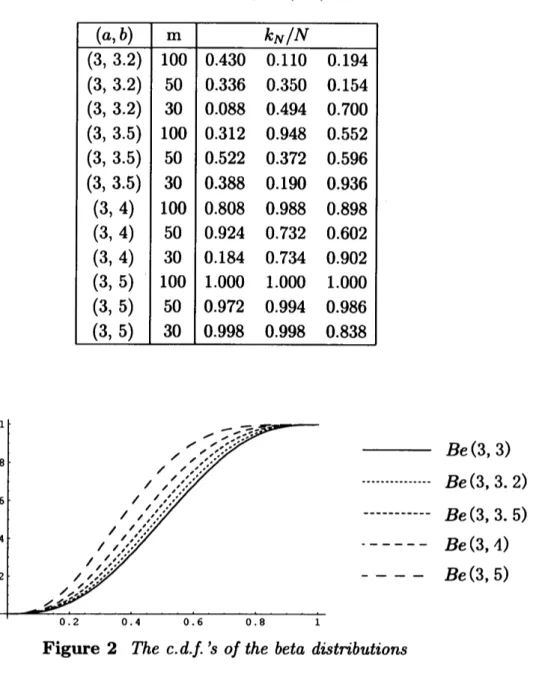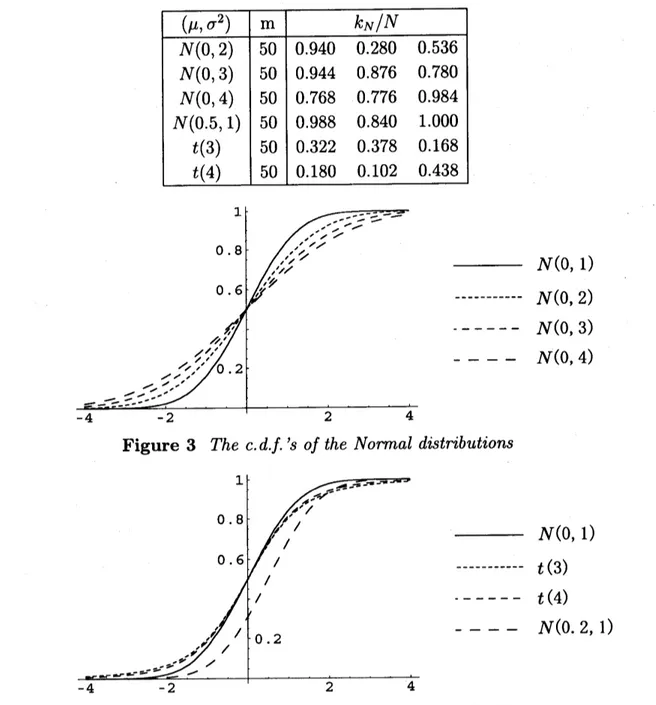A simulation
study
on
testing
the
hypothesis
in
the
tw0-sample problem
Masafumi Akahira
and
Kunihiko Takahashi
赤平 昌文 (筑波大・数学) 高橋 邦彦 (筑波大・数学)
Instituteof Mathematics, University ofTsukuba, Ibaraki 305-8571, Japan
Abstract
We consider the problem of comparing two population distributions $F$ and $G$ based
on
two samples $X_{1}$,$\ldots$ ,$X_{n}$ and $\mathrm{Y}_{1}$,
$\ldots$ ,$\mathrm{Y}_{m}$,
one
from each population. In testing thehypothesis $H$ : $F\equiv G$, we
assume
that the size $n$ of the sample is large, but$m$ is small.
Then
we
applythe Kolmogorov-Smirnov type test to thecase
using the resamplingmethodincluding the bootstrap, and carry out asimulation study on the power of the test under
some
populationdistributions.
1.
Kolmogorov-Smirnov
type test
Suppose that $X_{1}$,
$\ldots$ ,$X_{n}$
are
independent and identically distributed (i.i.d.) randomvariables according to the cumulative distribution function (c.d.f.) $F$ and $\mathrm{Y}_{1}$,
$\ldots$ ,$\mathrm{Y}_{m}$
are
i.i.d. random variables according to the c.d.f. $G$. In the
case
when $n$ is large but $m$ issmall,
we
consider the problem of testing hypothesis $H$ : $F\equiv G$. Now, let $F_{m}$ be theempiricaldistribution function (e.d.f.) based
on
resampling $X_{1}’$, . . .’$X_{m}’$with replacement
from $X_{1}$,
$\ldots$ ,$X_{n}$ and $G_{m}$ be the e.d.f. based
on
the bootstrap sample $\mathrm{Y}_{1}’$,$\ldots$ ,$\mathrm{Y}_{m-1}’$ of
size $m-1$ from the e.d.f. $F_{m}$. Here,
we
take $m-1$ instead of $m$ from the viewpoint ofthe
unbiasedness.
(For details,see
Akahira
and Takeuchi (1991), page 300). Thenwe
considerthe Kolmogorov-Smirnov type test of level $\alpha$
.
For any $\alpha(0<\alpha<1)$ there exists$c$ such that
$P \{\sup_{x}|F_{m}(x)-G_{m}(x)|\geq\frac{c}{m}\}=\alpha$.
Indeed, for $\alpha=0.05,0.01$, $m=1(1)15,20(5)30,40(10)100$ , the values of $c$
are
given byBirnbaum (1952) (see also Miller (1956))
数理解析研究所講究録 1224 巻 2001 年 182-186
Now, letting N be the repeated number of resampling X),\ldots t’
$X\ovalbox{\tt\small REJECT}$ with replacement
from $X_{1_{7}\ovalbox{\tt\small REJECT}\ovalbox{\tt\small REJECT}\ovalbox{\tt\small REJECT}}$
\rangle$X_{nt}$ for the e.d.f.
G.
we denote by$k_{N}$ the frequency number satisfying
$\sup_{x}|F_{m}(x)-G_{m}(x)|\geq c/m$
under the hypothesis $H:F\equiv G$. Then
we
make aruleon
testing hypothesisas
follows.If $k_{N}/N$ $\alpha$, then one rejects the hypothesis $H$, otherwise one accepts it. In asimilar
way to the above, under the alternative hypothesis $K$ : $F\not\equiv G$,
we
may regard $k_{N}/N$as
the power of the test with the rejection region. For example, in practice the above way
may be applied to the test of the effect of adrug.
2.
Simulation
study
In testing the hypothesis in the previous section
we
consider the followingcases.
(i) $F$ is the c.d.f. ofthe beta distribution Be(a,$b$) with the probability density function
$(\mathrm{p}.\mathrm{d}.\mathrm{f}.)$
$f(x)$ $=\{$
$\frac{1}{B(a,b)}x^{a-1}(1-x)^{b-1}$ for
$0<x<1$
,0otherwise,
where $a>0$ and $b>0$. Let $\alpha=0.05$. When $G$ is the c.d.f. of the beta distribution
Be$(4, 4)$, for $(a, b)=(4,5)$, (4,4.5), (4, 4.2) and $N=500$,
we
have the values of theapproximate power $k_{N}/N$
as
in Table 1. (See also Figure 1.) When $G$ is the c.d.f. of thebeta distributin Be$(3, 3))$ for $(a, b)=(3,3.2)$, (3,3.5), $(3, 4)$, $(3, 5)$ and $N=500$, we have
the values of the approximate power $k_{N}/N$ as in Table 2. (See also Figure 2.)
Table 1Comparison
of
the approximate power $k_{N}/N$of
the test in three simulationresults in case
of
Be(4, 4)Be$(4, 4)$
Be(4, 4. 2)
—— Be(4, 4. 5) ——- Be$(4, 5)$
Figure 1The
c.d.f.
’sof
the beta distributionsTable 2Comparison
of
the approimate power $k_{N}/N$of
the test in three simulationresults in
case
of
Be(3, 3) Be$(3, 3)$ Be(3, 3. 2) Be(3, 3. 5) —— Be$(3, 4)$ ——- Be$(3, 5)$Figure 2The
c.d.f.
’sof
the beta distributionsAs is
seen
from Table 1, the values of approximate powerare
comparatively stableexcept for the
cases
when $(a, b)=(4,4.5)$ and $m=1\mathrm{O}\mathrm{O}$,which
are
due to the first samplefrom the distribution Be$(4, 4)$. Table 2shows asimilar tendency to the result in Table 1.
(ii) Let $F$ be the c.d.f. of the standard normal distribution $N(0,1)$ and $G$ the c.d.f. of
$N(\mu, \sigma^{2})$. For $\alpha=0.05$, $(\mu, \sigma^{2})=(0,2)$,$(0, 3)$, $(0, 4)$, (0.5, 1) and $N=500$,
we
have thevalues of the approximate power $k_{N}/N$ is three simulation results
as
in Table 3. When$(\mu, \sigma^{2})=(0,2)$, they
seems
to be unstable.Table 3Comparison
of
the approximate power $k_{N}/N$of
the test in three simulationresults in
case
of
$N(0,$1)$N(0, 1)$ $N(0, 2)$
$——$
$N(0, 3)$$—-$
$N(0, 4)$Figure 3The
c.d.f.
’sof
the Normal distributions$N(0,1)$
$t(3)$
—— $t(4)$
——- $N(0.2,1)$
Figure 4The
c.d.f.
’sof
the Normal distributions and t-distribution3. Remarks
The
tw0-sample problem inthis paper
may be
applied tothe
foUowing
.
Suppose that
adrug is admitted
as
amarketableone
insome
countriesafter testingits efficacy bymanydata. When those date
are
available, the problem is how to test the efficacy of the drugby onlysmalldatain anothercountry. In theproblemthe size of small datais important,
and, according to
our
simulation study, the resultseems
to be comparatively stable forthe size 50, though it
may
dependon
the populationdistribution
and the first samplefrom it.
References
Akahira, M. and Takeuchi, K. (1991). Bootstrap
method
and empiricalprocess. Ann.
Inst.
Statist.
Math., 43,297-310.
Birnbaum, Z. W. (1952). Numerical tabulation of the distribution of Kolmogorov’s
statistic for finite sample size. J. Amer. Statist. Assoc, 47, 425-441.
Miller, L. H. (1956). Table of percentage points of Kolmogorov statistics. J.
Amer.
Statist. Assoc, 51, 111-121.
lSuch amedical problemwas brought by Prof. M. Takeuchi ofKitasato Universitytothefirst author


